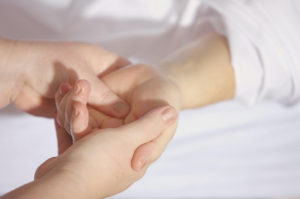5 Tips to Healing Wrist Pain After Pregnancy: Your Guide to Mommy Thumb

Hi, Dr Jafari here! I’m a Licensed Acupuncturist & Doctor of Oriental Medicine specializing in women’s health and postpartum care here in Los Angeles. In today’s blog post, I wanted to spend some time on a hugely relevant topic for lots of new mommas: the dreaded wrist and thumb pain.
It’s debilitating, crazy painful, and frustrating. At a certain point you’re wondering does mommy thumb go away or is it just going to linger on forever?! Spoiler alert: it’s not a forever thing nor does it need to be. With correct diagnosis and treatment you can be well on your way to a pain-free mommy life.
Mommy Thumb Causes: #1 De Quervain’s Tenosynovitis
For most mommas dealing with postpartum wrist and thumb pain, the most likely culprit is a little known condition called De Quervain’s Tenosynovitis. Sounds like a big, fancy word. But all it means is that the tendon and the tunnel through which it travels are inflamed and swollen. In this case, the tendons we are referring to are the abductor pollicus longus (APL) and the extensor pollicis brevis (EPB).
These tendons help you 1) abduct your thumb (move the thumb away from your hand) and 2) extend your thumb (straighten your thumb and pull it backwards). It’s incredible how much of our daily living activities requires these tiny motions.
De Quervain’s is not to be confused with carpal tunnel syndrome, which many people associate with hand pain. Carpal tunnel involves numbness and tingling of the first 3 fingers and pain in the palmar aspect of the wrist.
The tendons run through a sheath (like a tunnel) which allows them to glide and stretch smoothly. When the tendon sheaths are inflamed and swollen it’s as if the tunnel is on fire and obstructed with debris. This creates a lot of friction and greatly impacts your thumb/wrist mobility as well as causes a lot of pain.
There is an incredibly simple way to figure out if these tendons are the source of the problem: it’s called the Finkelstein test:
- You make a fist with your hand, but place your thumb inside the fist.
- Bend your wrist down towards the side of the little finger.
The test is positive if you feel pain in the wrist/thumb or if there’s pain radiating up the arm from the thumb.
While the exact cause of De Quervain’s is not known, it is generally accepted that the condition is associated with overuse and repetitive movements such as those typically done by a breastfeeding mother like you! So if you’re wondering why you get wrist pain after breastfeeding, this may be the answer.
De Quervain’s Symptoms
- Pain in the thumb or the thumb side of the wrist. This pain can radiate up the arm. The pain is triggered by specific movements, typically those that involve the wrist and thumb.
- Some people may have swelling around the thumb side of the wrist.
- Thumb and wrist range of motion are limited because of pain
Top 5 Tips on your Road to Recovery!
The great news is that most people recover with rest and time. Drastic measures like surgery are not commonly necessary. But sometimes, it feels like the injury lasts forever and just isn’t going away. It’s for this reason that we’ve compiled some of the best advice on how to speed up your recovery.
- Acupuncture: This should be #1 on your list. Acupuncture is incredibly effective at reducing pain and healing time. It’s also great at reducing swelling and inflammation, which helps give your hand more range of motion with less pain. Consider this your number one holistic alternative to a corticosteroid injection into the wrist.
- Use a splint: Give your thumb and wrist a break by immobilizing it using a splint. This helps prevent further aggravation of the injury and reduces swelling / pain. This is the cheapest and yet the hardest advice for so many new mommas. Telling them not to use one of their hands when they have to care for a newborn isn’t easy. It’s for this reason that you need support from the people around you. Spouse and surrounding family members should take a more active role in lifting the newborn and positioning the baby for you, so that you don’t have to do any of the heavy lifting.
- Limit your phone usage: Impossible, we know. But the thumb movement caused by texting and swiping on your phone screen is incredibly aggravating to someone with De Quervain’s. Try using your index finger to do all that work instead.
- Change the way you lift your baby: Most people lift their babies using an “L” shape with their hands (hands are under the baby’s armpit – thumb is on the baby’s chest and other four fingers are wrapped around the baby’s back). Avoid lifting your baby this way. Instead, try to “scoop” your baby. This means keeping the injured wrist/hand straight, palms facing upwards as if you’re trying to scoop some water into your hand. Gently lift your baby from beneath their bottom using this cupping motion with your hand.
- Breastfeeding position: There are various adjustments you can make to your breastfeeding routine that help alleviate stress on the wrist. The first is finding a comfortable way to use your own body to support the baby’s weight rather than depending on your arms and hands to do most of the heavy lifting. One way to achieve this is using a pillow under your arm while you breastfeed. Another method is breastfeeding while sitting in a reclined position and having your newborn rest on your chest: this allows you to support the baby fully using your body rather than your hands. Experiment and see what works best for you and your little one!
If your pain persists or gets worse, see a doctor immediately. They may offer anti-inflammatory drugs, ice therapy, cortisone shots, or, as a last resort, even surgery. My hope is that none of you reach that point. As soon as you feel an inkling of discomfort, I strongly urge you take a proactive and dedicated approach to healing your body!

